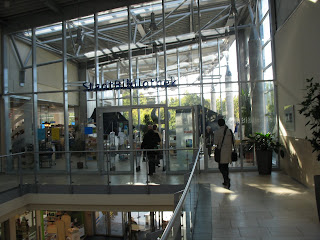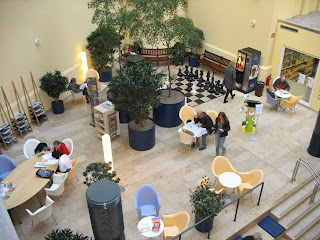
Self-learning (or autoformation as the French call it) appears to be much more popular in German and French public libraries than in American public libraries.With its recently opened Lern- und Sprach Centrum (Learning and Language Center), the Hamburg library has adopted the Information Commons idea from English and American universities and applied it, including e-learning and chat rooms, to the public library setting.
The library obtains its online courses from Bipmedia, a German/Austrian firm that provides online training to SAP, BMW and other companies. The library asked Bipmedia, which had never worked with libraries, if it could be on its platform, but Bipmedia offered to create a platform for the library to host instead. The library now offers 102 courses in IT, language, economics and other subjects and it has contracted with Bipmedia to sell this service to other libraries. The IT staff promoted the service at the recent Frankfurter Büchmesse, the world's largest book trade fair, where Leipzig and Frankfurt signed on.
The Hamburg library’s eMedia offer includes eBooks, eAudios, eVideos and eMusic, and ePaper (newspapers, journals and magazines), which it obtains from DiViBib GmbH, Wiesbaden, Germany. DiViBib buys the media from the publishers. The Hamburg library and 105 other German libraries, including Bremen, Frankfurt, Cologne, Munich and the Association of Public Libraries in Berlin buy licenses to use the media from the publisher. See http://www.onleihe.net
The ePaper incudes Der Speigel, the German news magazine; four national daily newspapers and Manager Magazin and Wirtschafts Woche, two business magazines. Under terms of its contract, the libraries can eloan Der Spiegel to only one customer at a time only. When I used the temporary Hamburg library card I was given (good for 30 days) to download the 156-page four-color most recent edition of Manager Magazin in pdf format, I was told my loan period was one day, three hours and 13 minutes. For Wirtschafts Woche my loan period was one day three hours and nine minutes.When I requested Der Spiegel, I was put on a waiting list. I received an email a few days later telling me that magazine was available for me to download.
Customers access the Learning and Language Center by clicking the eLEARNING link on the library’s home page. They access the library’s eMedia offering by clicking the emedien link on the home page.

The library’s website tells customers that with the new eLearning platform, Bücherhallen Hamburg is the first German library to give customers this new online offering. It tells them they can enter the world of online learning round the clock by choosing from more than 100 courses, including language, management and computer courses as well as courses to help them pass their European Computer Driver’s License exam. With the new eMedia service, the website says, the Bücherhallen Hamburg together with Stadtbibliotheken in München (Munich),Würzburg und Köln (Cologne) enter a new virtual world where it is possible for customers to choose the eMedia they want and need from a large pool. All they have to do to access this world of eLearning and eMedia is enter their library card number and PIN. The loan period for most eMedia is one week during which they can read or work with it whenever they want, or put it on a USB stick and take it with them to their weekend house. At the end of the week the loan expires and the items is longer be available to them.

Customers learn on the library’s website that to use the eLearning platform or the eMedia they need Windows 2000/XP/Vista, Windows Media Player 9 or higher; Adobe Reader 7.0 or higher; Internet Explorer 6.0 or higher; and Firefox 1.5.0 or higher. They are advised that they will be able to make only limited use of the eMedia with Mac or Linux operating system. It gives a list of MP3 players compatible with the system, and a list of compatible eBook readers, which currently includes only the Sony eBook Reader. (The Kindle is not yet available in Europe; but even if it were, it would not be listed because eBooks for the Kindle have to be purchased from Amazon.) The website also has tutorials customers can follow to learn how to use the eLearning platform and eMedia.
The eMedia offer includes more than 1,000 eBooks, eAudios, eVideos and 4,000 music titles. It can also be search by theme:
Children (207 titles): Adventure and Discovery, Detective and True Crime, Earth and Universe, Fantasy, Friendship & Family, For our Children, History, Religion & Folklore; Horror, Body & Health; Songs & Poetry; Fairytales, Sports, Games & Fun; Animals & Nature, Other;
Young Adult (241titles): Adventure and Excitement; Family, Friendship & Love; Fantasy & Science Fiction; Free Time & Sport; Horror & Mystery; Body & Health; Fairytales; Real Life; Travel, Lands & Cultures; Novels & Experiences; Animals & Nature; Other;
School & Learning (1702 titles): Reference; Work and Study Techniques; Career Choice and Application; Professions; Test Preparation; Other.
Nonfiction & Advice (9621 titles): Education & Study; Beauty & Wellness; Occupation & Career; Computer & Internet; Parenting; Esotericism & Astrology; History, Peoples & Lands; Society; Health; Home & Religion; Hobby & Lifestyle; Information & Documentation; Art, Culture & Media; Music; Practical Advice; Nature and the Cosmos; Pedagogy & Psychology; Politics; Law; Travel & Adventure; Religion & Philosophy; Sport & Fitness; Languages; Environment & Environmental Protection; Consumerism & Finance; Economy & Business; Science & Technology
Fiction & Entertainment (1153 titles): Biography & Memoir; Drama; Essays; True Crime & Thrillers; Verse; Fairytales; Oral Tradition & Humor; Novels & Experience; Science Fiction & Fantasy.
Music (4632 titles): Genre and Epoch.



























